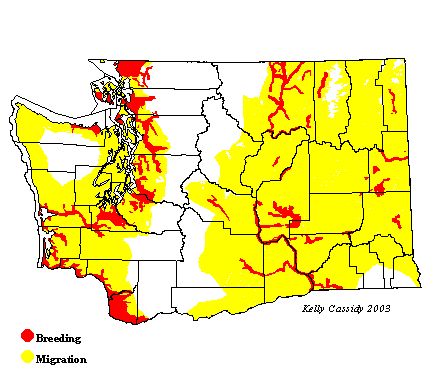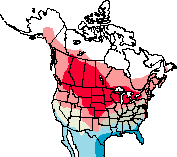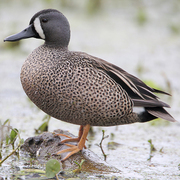Blue-winged Teal
General Description
Blue-winged Teal are small dabblers with long bodies and bills. Males in breeding plumage have russet-colored bodies with small, dark spots, black undertail coverts, and white patches on their flanks. Their heads are dark blue-gray with a distinctive white crescent in front of each eye. Males are in non-breeding or eclipse plumage from July to October, during which time they look like females and can easily be confused with Cinnamon Teal in the same plumage. Juveniles and females are mottled brown with a dark bill and yellowish legs. Both males and females have green-black speculums, with pale blue patches on the forewing.
Habitat
Blue-winged Teal inhabit shallow wetlands with emergent vegetation. Their breeding habitat is usually open-country wetlands. During migration they are sometimes found over the ocean, many miles from shore.
Behavior
Fast and agile flyers, Blue-winged Teal are often seen in small flocks, twisting and turning as a single unit. When foraging they usually stick to very shallow water, plucking food items from the surface and swimming with their heads partially submerged. They do not tend to up-end or feed out of the water.
Diet
Like other dabblers, Blue-winged Teal eat grass and aquatic plant seeds, as well as insects and other aquatic invertebrates. These invertebrates make up a larger proportion of their diet than that of other dabblers.
Nesting
Pair formation begins in the winter and continues through spring migration. Blue-winged Teal nest on the ground in prairies, coastal meadows, and other open areas. Nests are usually near water, but may be several hundred yards away. The nest is a shallow depression with some grass or weeds, lined with down and usually well concealed by vegetation. The female incubates 9 to 13 eggs alone for 23 to 24 days. The young leave the nest within a day of hatching and can swim and find their own food immediately. The female continues to protect and tend them for a few weeks, but she leaves them before they are old enough to fly, which happens around 38 to 49 days.
Migration Status
Blue-winged Teal are highly migratory and are, for the most part, absent from the majority of North America during the cold months of the year. They winter more extensively in South America than any other dabbler. They begin migrating later in spring than other dabblers, with birds arriving on the coast as early as March, but mostly not before April and May. Single males arrive first, with pairs and unpaired females following. Males migrate again from mid-July to mid-August, moving to larger marshes to undergo their molt. Fall migration starts in early August, and most birds are gone by mid-October.
Conservation Status
Numbers of Blue-winged Teal nesting in Washington have increased dramatically in the last century. Blue-winged Teal now outnumber Cinnamon Teal in some parts of eastern Washington. This shift is most likely due to large damming projects that have converted small wetlands into large reservoirs more favorable to the Blue-winged than the Cinnamon Teal.
When and Where to Find in Washington
Blue-winged Teal are extremely rare in Washington during winter. They typically arrive in mid-April and depart by the end of September. West of the Cascades they are uncommon breeders, and their range is somewhat limited to freshwater wetlands in the Puget Trough and coastal areas. In eastern Washington, they are common in wetlands throughout the region.
 Abundance
Abundance
| Ecoregion | Jan | Feb | Mar | Apr | May | Jun | Jul | Aug | Sep | Oct | Nov | Dec |
|---|---|---|---|---|---|---|---|---|---|---|---|---|
| Oceanic | ||||||||||||
| Pacific Northwest Coast | R | U | U | U | U | U | R | |||||
| Puget Trough | R | F | F | U | U | R | ||||||
| North Cascades | R | R | R | |||||||||
| West Cascades | U | U | U | U | U | U | ||||||
| East Cascades | U | U | R | R | U | U | ||||||
| Okanogan | C | C | C | C | ||||||||
| Canadian Rockies | F | F | F | F | F | |||||||
| Blue Mountains | U | U | R | |||||||||
| Columbia Plateau | F | C | C | C | F | U |
Washington Range Map

North American Range Map


Family Members
 Fulvous Whistling-DuckDendrocygna bicolor
Fulvous Whistling-DuckDendrocygna bicolor Taiga Bean-GooseAnser fabalis
Taiga Bean-GooseAnser fabalis Greater White-fronted GooseAnser albifrons
Greater White-fronted GooseAnser albifrons Emperor GooseChen canagica
Emperor GooseChen canagica Snow GooseChen caerulescens
Snow GooseChen caerulescens Ross's GooseChen rossii
Ross's GooseChen rossii BrantBranta bernicla
BrantBranta bernicla Cackling GooseBranta hutchinsii
Cackling GooseBranta hutchinsii Canada GooseBranta canadensis
Canada GooseBranta canadensis Mute SwanCygnus olor
Mute SwanCygnus olor Trumpeter SwanCygnus buccinator
Trumpeter SwanCygnus buccinator Tundra SwanCygnus columbianus
Tundra SwanCygnus columbianus Wood DuckAix sponsa
Wood DuckAix sponsa GadwallAnas strepera
GadwallAnas strepera Falcated DuckAnas falcata
Falcated DuckAnas falcata Eurasian WigeonAnas penelope
Eurasian WigeonAnas penelope American WigeonAnas americana
American WigeonAnas americana American Black DuckAnas rubripes
American Black DuckAnas rubripes MallardAnas platyrhynchos
MallardAnas platyrhynchos Blue-winged TealAnas discors
Blue-winged TealAnas discors Cinnamon TealAnas cyanoptera
Cinnamon TealAnas cyanoptera Northern ShovelerAnas clypeata
Northern ShovelerAnas clypeata Northern PintailAnas acuta
Northern PintailAnas acuta GarganeyAnas querquedula
GarganeyAnas querquedula Baikal TealAnas formosa
Baikal TealAnas formosa Green-winged TealAnas crecca
Green-winged TealAnas crecca CanvasbackAythya valisineria
CanvasbackAythya valisineria RedheadAythya americana
RedheadAythya americana Ring-necked DuckAythya collaris
Ring-necked DuckAythya collaris Tufted DuckAythya fuligula
Tufted DuckAythya fuligula Greater ScaupAythya marila
Greater ScaupAythya marila Lesser ScaupAythya affinis
Lesser ScaupAythya affinis Steller's EiderPolysticta stelleri
Steller's EiderPolysticta stelleri King EiderSomateria spectabilis
King EiderSomateria spectabilis Common EiderSomateria mollissima
Common EiderSomateria mollissima Harlequin DuckHistrionicus histrionicus
Harlequin DuckHistrionicus histrionicus Surf ScoterMelanitta perspicillata
Surf ScoterMelanitta perspicillata White-winged ScoterMelanitta fusca
White-winged ScoterMelanitta fusca Black ScoterMelanitta nigra
Black ScoterMelanitta nigra Long-tailed DuckClangula hyemalis
Long-tailed DuckClangula hyemalis BuffleheadBucephala albeola
BuffleheadBucephala albeola Common GoldeneyeBucephala clangula
Common GoldeneyeBucephala clangula Barrow's GoldeneyeBucephala islandica
Barrow's GoldeneyeBucephala islandica SmewMergellus albellus
SmewMergellus albellus Hooded MerganserLophodytes cucullatus
Hooded MerganserLophodytes cucullatus Common MerganserMergus merganser
Common MerganserMergus merganser Red-breasted MerganserMergus serrator
Red-breasted MerganserMergus serrator Ruddy DuckOxyura jamaicensis
Ruddy DuckOxyura jamaicensis

